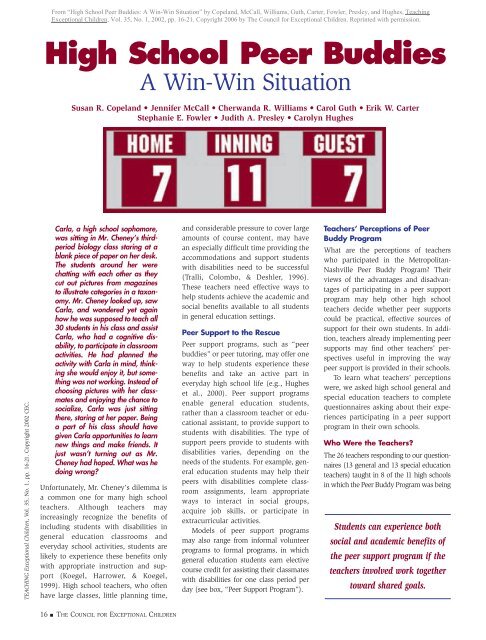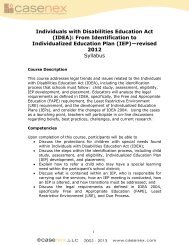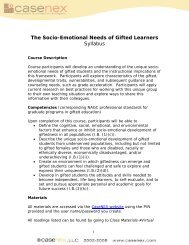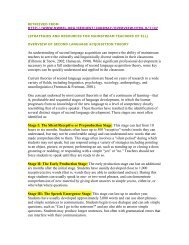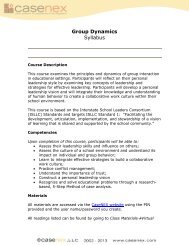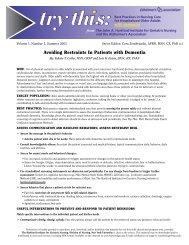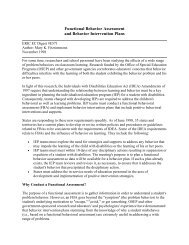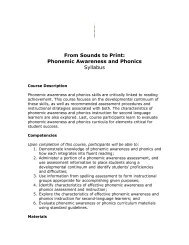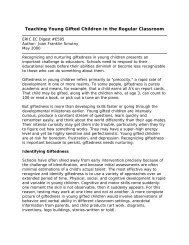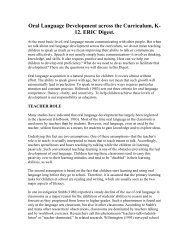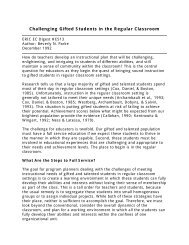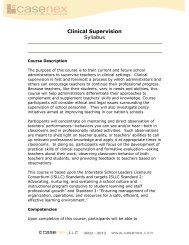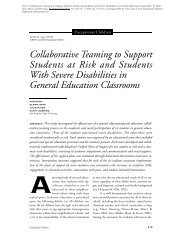High School Peer Buddies: A Win-Win Situation - Casenex
High School Peer Buddies: A Win-Win Situation - Casenex
High School Peer Buddies: A Win-Win Situation - Casenex
Create successful ePaper yourself
Turn your PDF publications into a flip-book with our unique Google optimized e-Paper software.
From “<strong>High</strong> <strong>School</strong> <strong>Peer</strong> <strong>Buddies</strong>: A <strong>Win</strong>-<strong>Win</strong> <strong>Situation</strong>” by Copeland, McCall, Williams, Guth, Carter, Fowler, Presley, and Hughes, Teaching<br />
Exceptional Children, Vol. 35, No. 1, 2002, pp. 16-21. Copyright 2006 by The Council for Exceptional Children. Reprinted with permission.<br />
<strong>High</strong> <strong>School</strong> <strong>Peer</strong> <strong>Buddies</strong><br />
A <strong>Win</strong>-<strong>Win</strong> <strong>Situation</strong><br />
Susan R. Copeland • Jennifer McCall • Cherwanda R. Williams • Carol Guth • Erik W. Carter<br />
Stephanie E. Fowler • Judith A. Presley • Carolyn Hughes<br />
TEACHING Exceptional Children, Vol. 35, No. 1, pp. 16-21. Copyright 2002 CEC.<br />
Carla, a high school sophomore,<br />
was sitting in Mr. Cheney’s thirdperiod<br />
biology class staring at a<br />
blank piece of paper on her desk.<br />
The students around her were<br />
chatting with each other as they<br />
cut out pictures from magazines<br />
to illustrate categories in a taxonomy.<br />
Mr. Cheney looked up, saw<br />
Carla, and wondered yet again<br />
how he was supposed to teach all<br />
30 students in his class and assist<br />
Carla, who had a cognitive disability,<br />
to participate in classroom<br />
activities. He had planned the<br />
activity with Carla in mind, thinking<br />
she would enjoy it, but something<br />
was not working. Instead of<br />
choosing pictures with her classmates<br />
and enjoying the chance to<br />
socialize, Carla was just sitting<br />
there, staring at her paper. Being<br />
a part of his class should have<br />
given Carla opportunities to learn<br />
new things and make friends. It<br />
just wasn’t turning out as Mr.<br />
Cheney had hoped. What was he<br />
doing wrong?<br />
Unfortunately, Mr. Cheney’s dilemma is<br />
a common one for many high school<br />
teachers. Although teachers may<br />
increasingly recognize the benefits of<br />
including students with disabilities in<br />
general education classrooms and<br />
everyday school activities, students are<br />
likely to experience these benefits only<br />
with appropriate instruction and support<br />
(Koegel, Harrower, & Koegel,<br />
1999). <strong>High</strong> school teachers, who often<br />
have large classes, little planning time,<br />
and considerable pressure to cover large<br />
amounts of course content, may have<br />
an especially difficult time providing the<br />
accommodations and support students<br />
with disabilities need to be successful<br />
(Tralli, Colombo, & Deshler, 1996).<br />
These teachers need effective ways to<br />
help students achieve the academic and<br />
social benefits available to all students<br />
in general education settings.<br />
<strong>Peer</strong> Support to the Rescue<br />
<strong>Peer</strong> support programs, such as “peer<br />
buddies” or peer tutoring, may offer one<br />
way to help students experience these<br />
benefits and take an active part in<br />
everyday high school life (e.g., Hughes<br />
et al., 2000). <strong>Peer</strong> support programs<br />
enable general education students,<br />
rather than a classroom teacher or educational<br />
assistant, to provide support to<br />
students with disabilities. The type of<br />
support peers provide to students with<br />
disabilities varies, depending on the<br />
needs of the students. For example, general<br />
education students may help their<br />
peers with disabilities complete classroom<br />
assignments, learn appropriate<br />
ways to interact in social groups,<br />
acquire job skills, or participate in<br />
extracurricular activities.<br />
Models of peer support programs<br />
may also range from informal volunteer<br />
programs to formal programs, in which<br />
general education students earn elective<br />
course credit for assisting their classmates<br />
with disabilities for one class period per<br />
day (see box, “<strong>Peer</strong> Support Program”).<br />
Teachers’ Perceptions of <strong>Peer</strong><br />
Buddy Program<br />
What are the perceptions of teachers<br />
who participated in the Metropolitan-<br />
Nashville <strong>Peer</strong> Buddy Program? Their<br />
views of the advantages and disadvantages<br />
of participating in a peer support<br />
program may help other high school<br />
teachers decide whether peer supports<br />
could be practical, effective sources of<br />
support for their own students. In addition,<br />
teachers already implementing peer<br />
supports may find other teachers’ perspectives<br />
useful in improving the way<br />
peer support is provided in their schools.<br />
To learn what teachers’ perceptions<br />
were, we asked high school general and<br />
special education teachers to complete<br />
questionnaires asking about their experiences<br />
participating in a peer support<br />
program in their own schools.<br />
Who Were the Teachers?<br />
The 26 teachers responding to our questionnaires<br />
(13 general and 13 special education<br />
teachers) taught in 8 of the 11 high schools<br />
in which the <strong>Peer</strong> Buddy Program was being<br />
Students can experience both<br />
social and academic benefits of<br />
the peer support program if the<br />
teachers involved work together<br />
toward shared goals.<br />
16 ■ THE COUNCIL FOR EXCEPTIONAL CHILDREN
implemented in the Metropolitan-Nashville<br />
school district. The mean ethnicity of the<br />
student populations of the 8 high schools<br />
ranged from: 22% to 71% Caucasian; 24%<br />
to 73% African American; 2% to 13%<br />
Asian; 1% to 3% Hispanic; and 0% to 1%<br />
American Indian. Some of the teachers we<br />
questioned were fairly new to the classroom<br />
(1 to 3 years experience), whereas others<br />
were veteran teachers (15 years’ experience<br />
or more). Seventeen of the 26 teachers were<br />
female; 18 were Caucasian, 7 were African<br />
American, and 1 was Hispanic. All teachers<br />
had at least 1 year of experience participating<br />
in a <strong>Peer</strong> Buddy Program in their classrooms,<br />
and most had been involved with<br />
the program for 4 years or more.<br />
The general education teachers who<br />
responded taught a variety of academic<br />
or vocational classes, such as physical<br />
education, culinary arts, keyboarding,<br />
and honors biology. Each teacher had<br />
one to five students with moderate or<br />
severe disabilities included in at least<br />
one of their classes, supported by one or<br />
more <strong>Peer</strong> <strong>Buddies</strong>.<br />
The special education teachers<br />
responding to the questionnaires were<br />
responsible for the general supervision<br />
of the <strong>Peer</strong> Buddy Programs in their<br />
schools and for the overall support of<br />
students with moderate or severe disabilities<br />
taking general education classes.<br />
In addition, these teachers supervised<br />
<strong>Peer</strong> <strong>Buddies</strong> who supported students<br />
in self-contained special education<br />
classrooms and community-based<br />
and employment training activities.<br />
What Did the Teachers Say?<br />
We analyzed general and special education<br />
teachers’ responses to the questionnaires<br />
by reviewing each individual<br />
response and identifying broad themes<br />
<strong>Peer</strong> Support Program in Metropolitan Nashville<br />
Students and faculty at a large high school in Nashville, Tennessee, teamed up<br />
with Vanderbilt University researchers to develop a peer buddy program that<br />
would increase the participation of students with disabilities in everyday high<br />
school activities. The program then was expanded to all 11 comprehensive high<br />
schools in the Metropolitan-Nashville school district.<br />
The core of the program is an elective credit course in which general education<br />
students learn about types of disabilities, learning differences, and instructional<br />
and motivational techniques and gain ideas on how to help their peers with moderate<br />
or severe disabilities become active participants in daily school activities.<br />
<strong>Peer</strong> <strong>Buddies</strong> spend at least one class period each day providing the supports<br />
that their peers with disabilities need to be included in general education classes<br />
and extracurricular activities.<br />
Interested general education students initially are screened by the school guidance<br />
counselors for attendance, interest, and adequate grade-point average.<br />
Students are required to complete a short application form and furnish a reference<br />
from a teacher who knows them well. They are interviewed by the special<br />
education teacher to whom they will be assigned and are given an opportunity<br />
to observe and ask questions about the program. If accepted as <strong>Peer</strong> <strong>Buddies</strong>,<br />
they are provided a brief orientation and matched with a particular student or<br />
group of students with disabilities.<br />
<strong>Peer</strong> <strong>Buddies</strong> provide supports to these partner(s) daily in a variety of settings.<br />
They may, for example, accompany their partners to a school pep rally, introduce<br />
them to other general education students during lunch, help them complete a lab<br />
project in a science class, or teach them to set tables at a restaurant serving as<br />
a job training site.<br />
Often <strong>Peer</strong> <strong>Buddies</strong> complete brief written reflections about their experiences and<br />
share these with the teacher supervising the program. Course grades are based<br />
on attendance, positive attitudes, and active participation.<br />
For step-by-step information on how to implement a formal peer buddy program,<br />
see Hughes et al. (1999).<br />
found across all responses. Three major<br />
themes emerged from this process: (a)<br />
benefits of participating in peer support<br />
programs for students with disabilities,<br />
general education peers, and teachers; (b)<br />
challenges teachers faced in implementing<br />
peer supports in their schools; and (c)<br />
recommendations for others interested in<br />
having general education peers support<br />
high school students with disabilities. In<br />
the following sections, we present what<br />
teachers said within the context of these<br />
themes and discuss implications that their<br />
perceptions may have for practice.<br />
Benefits<br />
For Students With Disabilities<br />
Social Versus Academic Skills. The<br />
majority of benefits for students with<br />
disabilities mentioned by special education<br />
teachers were social-related, such<br />
as increased opportunities for interaction<br />
with general education peers and<br />
acquisition of age-appropriate social<br />
skills. For example, some teachers mentioned<br />
that their students had often<br />
acted inappropriately in social settings<br />
before receiving peer supports, but used<br />
more appropriate social behaviors after<br />
they developed relationships with the<br />
general education students who provided<br />
them with support.<br />
In contrast, the responses of general<br />
education teachers primarily emphasized<br />
benefits for students with disabilities that<br />
related to academic or functional skills.<br />
Their responses focused on students’<br />
“learning useful skills” or being provided<br />
with additional opportunities for individual<br />
instruction as a result of receiving<br />
support from <strong>Peer</strong> <strong>Buddies</strong>.<br />
The contrast in perceived benefits<br />
between general and special education<br />
teachers may indicate that these teachers<br />
have differing instructional priorities<br />
for students with disabilities. This difference<br />
suggests that it may be important<br />
for teachers to discuss each other’s<br />
expectations for student participation in<br />
a peer support program. Students can<br />
experience both social and academic<br />
benefits as a result of receiving peer<br />
supports if the teachers involved work<br />
together toward shared goals.<br />
Positive Relationships. Positive relationships<br />
between <strong>Peer</strong> <strong>Buddies</strong> and their<br />
TEACHING EXCEPTIONAL CHILDREN ■ SEPT/OCT 2002 ■ 17
partners with disabilities were mentioned<br />
by general and special educators as an<br />
additional benefit. Teachers characterized<br />
relationships between <strong>Peer</strong> <strong>Buddies</strong> and<br />
partners as ranging from helping- to<br />
socially-oriented relationships. Several<br />
teachers described these relationships as<br />
similar to those between students without<br />
disabilities. A number of teachers commented<br />
that <strong>Peer</strong> <strong>Buddies</strong> and partners<br />
became friends as a result of their interactions<br />
with one another.<br />
Students with disabilities often have<br />
limited opportunities to develop typical<br />
relationships with their general education<br />
peers. Participation in a peer support<br />
program can increase opportunities for<br />
these students to form peer relationships<br />
similar to those between high school students<br />
without disabilities. Because the<br />
role assigned to the <strong>Peer</strong> Buddy (i.e.,<br />
instructional vs. non-instructional) may<br />
influence the nature of the relationship<br />
that develops between the Buddy and<br />
the partner, <strong>Peer</strong> Buddy roles should be<br />
based on the individual needs of the students<br />
who will be supported.<br />
Enhanced Personal Growth. Another<br />
benefit general and special education<br />
teachers reported for students with disabilities<br />
was enhanced personal growth.<br />
Teachers noted that students who<br />
received support from peers seemed<br />
more independent and had greater selfconfidence<br />
as they interacted with <strong>Peer</strong><br />
<strong>Buddies</strong>. This increased self-confidence<br />
made students more eager and willing<br />
to participate in everyday high school<br />
activities with their peers, a goal consistent<br />
with the intent of current educational<br />
legislation (i.e., IDEA<br />
Amendments of 1997).<br />
“The relationships between the<br />
<strong>Peer</strong> <strong>Buddies</strong> and the students<br />
with disabilities were great. They<br />
enjoyed being with each other.<br />
They also did things together<br />
outside of class.”<br />
Currently there is much discussion in<br />
the field of special education related to<br />
developing strategies that help students<br />
become more active participants in all<br />
facets of school life. Respondents’ comments<br />
suggest that receiving peer supports<br />
may be an effective, and relatively<br />
simple way for students with disabilities<br />
to acquire some of the skills needed to<br />
become active members of the school<br />
community. <strong>Peer</strong> support may allow<br />
students with disabilities opportunities<br />
to first observe their general education<br />
peers modeling appropriate behaviors<br />
and then to “try out” new social and<br />
interpersonal skills.<br />
Less Disruption. The majority of special<br />
and general education teachers agreed<br />
that <strong>Peer</strong> <strong>Buddies</strong> assisted and interacted<br />
with the students they were supporting<br />
in a manner that did not disrupt the<br />
classroom routine or draw attention to<br />
the students receiving supports. As one<br />
general education teacher remarked,<br />
“The <strong>Peer</strong> Buddy worked quietly. The<br />
class was not aware of her role.”<br />
Teachers’ remarks suggest that students<br />
can receive the supports they<br />
need from peers in a manner that neither<br />
hampers the ongoing routine of a<br />
classroom nor singles students out as<br />
“different” from their peers, an important<br />
consideration when working with<br />
any adolescent.<br />
For General Education Students<br />
Socializing Opportunities for All<br />
Students. Teachers commented that<br />
having students with disabilities and<br />
their <strong>Peer</strong> <strong>Buddies</strong> participate in general<br />
education classes and activities provided<br />
general education students with<br />
opportunities to get to know peers with<br />
whom they might not have otherwise<br />
interacted. Teachers mentioned that as a<br />
result of working and socializing with<br />
classmates with disabilities, general<br />
education students’ perspectives broadened,<br />
and the students became more<br />
aware of issues related to disabilities.<br />
For example, one teacher said that<br />
“often special education students add a<br />
different viewpoint and way of seeing”<br />
during classroom discussion. Another<br />
teacher remarked that his general education<br />
students benefited when he was<br />
able to “expose the general education<br />
“Roles often were reversed, and<br />
students with disabilities served<br />
as positive role models for general<br />
education classmates.”<br />
students to the students with disabilities<br />
and let them help each other.”<br />
Reversed Role Models. Although teachers<br />
and administrators typically think of general<br />
education students as being role models<br />
for their classmates with disabilities,<br />
teachers we questioned noted that often<br />
these roles were reversed, and students<br />
with disabilities served as positive role<br />
models for general education classmates.<br />
One teacher, for example, related that the<br />
general education students in her classroom<br />
benefited from seeing how interested<br />
their peer with a disability was in the<br />
subject matter and how he carefully used<br />
his time to complete assignments.<br />
Increased Diversity. Increased diversity<br />
in classes and activities can lead to<br />
increased learning and personal growth<br />
for students and teachers, alike. <strong>Peer</strong><br />
supports that allow students with disabilities<br />
to become active participants in<br />
classes and extracurricular activities<br />
may be an effective way to increase<br />
diversity and encourage learning about<br />
human differences and similarities.<br />
For General Education Teachers<br />
Assistance With Instruction. A benefit<br />
for teachers of having peer supports in the<br />
classroom may be assistance in providing<br />
instruction to students with disabilities.<br />
General education teachers appeared to<br />
feel overwhelmed at times by the<br />
demands of teaching a widely diverse<br />
group of learners. Teachers viewed having<br />
<strong>Peer</strong> <strong>Buddies</strong> available to work individually<br />
with students on class assignments or<br />
to help students actively participate in<br />
classroom and extracurricular activities<br />
with peers as a primary benefit of participating<br />
in a peer support program.<br />
General education students can provide<br />
a variety of supports for their classmates<br />
with disabilities in ways that<br />
decrease the amount of time teachers<br />
spend providing one-to-one instruction.<br />
<strong>Peer</strong> support should be tailored to the<br />
18 ■ THE COUNCIL FOR EXCEPTIONAL CHILDREN
"Prior to receiving peer supports<br />
these students tended to isolate<br />
themselves from the general<br />
education students. I have noticed<br />
that they are now willing (and<br />
seeking) to contact students<br />
outside of their special education<br />
group."<br />
individual learning goals and needs of<br />
each student within the context of a particular<br />
class (see box, “Supporting<br />
Classmates With Disabilities”).<br />
Professional Growth. Professional<br />
growth may be another personal benefit<br />
for teachers who participate in a peer<br />
support program. Several teachers<br />
remarked that peer support programs,<br />
such as the <strong>Peer</strong> Buddy Program,<br />
allowed them to “experience the whole<br />
spectrum of teaching all students,” and,<br />
for the first time, they realized how students<br />
with disabilities could benefit<br />
from inclusion in general education<br />
classes. Many reported feeling personal<br />
satisfaction because they were now<br />
helping all their students learn.<br />
Personal Satisfaction. Many high<br />
school teachers report feeling frustrated<br />
by the lack of time available to complete<br />
the multiple daily tasks that make up their<br />
jobs. Implementing peer supports may<br />
allow teachers to experience genuine satisfaction<br />
in knowing that the learning<br />
needs of all their students are being met<br />
and to celebrate the joy of watching<br />
young people master new skills.<br />
Challenges<br />
Scheduling and Planning<br />
The challenges of participating in a peer<br />
support program most frequently mentioned<br />
by general education teachers related<br />
to scheduling and planning. Several<br />
teachers expressed concern that more students<br />
with disabilities had been enrolled<br />
in their classrooms than could be appropriately<br />
supported by the number of <strong>Peer</strong><br />
<strong>Buddies</strong> available. Some teachers also<br />
commented that students with disabilities<br />
were regularly pulled out of their classes<br />
for other scheduled activities (e.g., community-based<br />
instruction), making it difficult<br />
to ensure that students received adequate<br />
instruction. Related to this issue,<br />
some general education teachers reported<br />
a lack of clear communication between<br />
themselves and special educators concerning<br />
the purpose of students being<br />
included in general education classes.<br />
They commented that they didn’t always<br />
understand why a student with a disability<br />
was enrolled in a particular class or<br />
how the student could benefit from learning<br />
the content taught in that class.<br />
If students with disabilities are to be<br />
accepted as class members, they must<br />
attend class regularly, just as their general<br />
education classmates do. In addition,<br />
the classroom teacher must be<br />
informed of these students’ individual<br />
learning goals prior to their inclusion in<br />
the class in order to plan and adapt<br />
instruction appropriately.<br />
Supporting Classmates With Disabilities<br />
The supports that peers provide can take many different forms. Here are some<br />
ideas that teachers suggested:<br />
• Teach classroom routines to their classmates (e.g., where to put homework,<br />
what to do when you first get to class, or where to find materials).<br />
• Read a test to a classmate and record his or her answers.<br />
• Read or record selections from a textbook for a classmate, paraphrasing as<br />
needed.<br />
• Help a student who uses an augmentative communication device explain to<br />
classmates how he uses the device to communicate.<br />
• Help a classmate “dress out” for physical education class.<br />
• Model for a student how he or she can ask to join in an activity.<br />
• Teach a classmate how to follow a picture schedule and locate his or her classes.<br />
• Tutor a classmate in a specific skill, such as learning how to read a list of community<br />
words.<br />
• Show a classmate how to “surf the Net” to find information for a classroom<br />
report.<br />
• Take notes for a classmate during a teacher lecture and spend time discussing<br />
the notes and answering questions at the end of the period.<br />
• Help a classmate fulfill her assigned role during cooperative learning activities.<br />
• Get a classmate involved in conversations with other general education students<br />
during “free time” at the end of the class period.<br />
• Work with a classmate to create a video report on an assigned topic.<br />
<strong>Peer</strong> Buddy Preparation<br />
Some teachers discussed challenges<br />
they faced when <strong>Peer</strong> <strong>Buddies</strong> lacked<br />
adequate preparation for the support<br />
roles they were expected to fill. For<br />
example, one teacher remarked that<br />
<strong>Peer</strong> <strong>Buddies</strong>’ lack of knowledge of<br />
course content limited the support they<br />
were able to provide. Other teachers<br />
mentioned that some <strong>Peer</strong> <strong>Buddies</strong> tried<br />
to “do too much” for the peers they<br />
were assisting. Some teachers noted<br />
that problems arose when <strong>Peer</strong> <strong>Buddies</strong><br />
did not keep in mind what their role in<br />
the class was, and this confusion led to<br />
problems. For example, sometimes <strong>Peer</strong><br />
<strong>Buddies</strong> failed to monitor their partners’<br />
classwork and did not offer support<br />
when it was needed. Finally, frequent<br />
absences by some <strong>Peer</strong> <strong>Buddies</strong> created<br />
problems for teachers and for the students<br />
with disabilities who counted on<br />
their <strong>Buddies</strong> for support.<br />
These responses underscore the<br />
importance of selecting general education<br />
students who are familiar with class<br />
content and providing them with clear<br />
guidelines on what is expected of them.<br />
Although participating general education<br />
TEACHING EXCEPTIONAL CHILDREN ■ SEPT/OCT 2002 ■ 19
"One student left my class every<br />
other day to work off campus in a<br />
special program, and it was very<br />
difficult to keep him caught up.<br />
He missed too much and always<br />
felt at a loss."<br />
students do not have to be A students,<br />
involving reliable, interested students is<br />
likely to result in successful outcomes.<br />
Teachers’ Recommendations<br />
General and special educators offered<br />
many suggestions for teachers interested<br />
in having general education peers support<br />
participation of students with disabilities<br />
in general education classes and activities.<br />
• Thoroughly screen general education<br />
students wishing to support their<br />
peers with disabilities to ensure that<br />
students selected have the interests<br />
and skills needed to assist their classmates<br />
with disabilities. To maximize<br />
effectiveness of the screening process,<br />
solicit input from all school staff<br />
involved in the peer support program<br />
(e.g., guidance counselors, administrators,<br />
general and special education<br />
teachers).<br />
• Develop an active recruitment process<br />
to increase the number of general education<br />
students available to support<br />
students with disabilities. Involve all<br />
school personnel participating in the<br />
peer support program in recruiting<br />
new <strong>Peer</strong> <strong>Buddies</strong>. Employ personal<br />
contact with individual general education<br />
students as an effective recruiting<br />
tool. Emphasize recruitment of upperlevel<br />
(junior and senior) students and<br />
If students with disabilities are to<br />
be accepted as class members,<br />
they must attend class regularly,<br />
just as their general education<br />
classmates do.<br />
remember to recruit both female and<br />
male general education peers.<br />
• Establish clear expectations of the support<br />
role <strong>Peer</strong> <strong>Buddies</strong> are to fill and<br />
clearly explain these expectations to<br />
<strong>Peer</strong> <strong>Buddies</strong> before the beginning of<br />
class. Provide <strong>Peer</strong> <strong>Buddies</strong> with regular<br />
feedback on performance as a support<br />
provider and give them opportunities<br />
to ask questions and talk about<br />
their experiences.<br />
• Remember that <strong>Peer</strong> <strong>Buddies</strong> are not<br />
educational assistants. Assign support<br />
tasks that are appropriate for<br />
student volunteers. For example, it<br />
would not be appropriate to leave a<br />
<strong>Peer</strong> Buddy in sole charge of a classroom<br />
while the teacher left to run an<br />
errand.<br />
• Enroll no more than one or two students<br />
with moderate or severe disabilities<br />
accompanied by one <strong>Peer</strong> Buddy in<br />
a single general education class. This<br />
maintains natural proportions of students<br />
with and without disabilities and<br />
ensures that students who need supports<br />
receive them.<br />
• Talk with general education classmates<br />
before including a student with<br />
a disability in the class. Answer students’<br />
questions and clarify your<br />
expectations both for the student with<br />
a disability and his or her general education<br />
classmates.<br />
• Model acceptance of and appropriate<br />
interactions with students with disabilities.<br />
Encourage the development<br />
of age-appropriate relationships<br />
between students with disabilities,<br />
their <strong>Peer</strong> <strong>Buddies</strong>, and other general<br />
education students in the class.<br />
• Involve students with disabilities in<br />
the same activities as their general<br />
education peers. Doing so will help<br />
students be viewed as “real” class<br />
members and provide opportunities<br />
for them to acquire new skills.<br />
Provide accommodations and assistance<br />
in a way that does not call<br />
undue attention to the student with a<br />
disability.<br />
• Increase the number of general education<br />
teachers providing peer supports<br />
for students with disabilities in<br />
their classes. To do so, gain administrative<br />
backing for the peer support<br />
program, provide teacher inservices<br />
describing the benefits of such programs<br />
to teachers and students, and<br />
furnish opportunities for interested<br />
teachers to visit classrooms in which<br />
peers were supporting students with<br />
disabilities.<br />
• Create a newsletter that includes<br />
ideas, activities, and stories related to<br />
teachers’ and students’ experiences in<br />
supporting students with disabilities<br />
in general education settings. Use the<br />
newsletter as a recruiting tool for<br />
involving additional general education<br />
students and teachers. The<br />
newsletter can also be a way for<br />
teachers to share creative strategies<br />
for having students support their<br />
peers with disabilities.<br />
Final Thoughts<br />
As illustrated by Mr. Cheney’s dilemma<br />
at the beginning of this article, high<br />
school teachers need practical, effective<br />
methods of increasing the participation<br />
of students with disabilities in their<br />
classrooms and in everyday high school<br />
activities. The comments of the teachers<br />
responding to our questionnaires indicate<br />
that having general education peers<br />
support their classmates with disabilities<br />
may meet this need. <strong>Peer</strong> supports<br />
not only allow students with disabilities<br />
to experience the benefits available in<br />
general education settings, but also provide<br />
valued benefits to their <strong>Peer</strong><br />
<strong>Buddies</strong>, their general education classmates,<br />
and their teachers. As one<br />
teacher remarked, “The <strong>Peer</strong> Buddy<br />
Program is a win-win situation!”<br />
Additional Resources<br />
Janney, M. E., & Snell, R. (2000). Social<br />
relationships and peer support.<br />
Baltimore: Paul H. Brookes.*<br />
Metropolitan-Nashville <strong>Peer</strong> Buddy Web Site<br />
(http://www.transitionlink.com/peerbuddy/).<br />
This Web site provides an<br />
overview of the program, step-bystep<br />
guide for implementation of a<br />
formal peer buddy program, and<br />
links to additional related sites.<br />
References<br />
Hughes, C., Guth, C., Hall, S., Presley, J.,<br />
Dye, M., & Byers, C. (1999). “They are my<br />
best friends.” <strong>Peer</strong> <strong>Buddies</strong> promote inclusion<br />
in high school. TEACHING<br />
Exceptional Children, 31, 32-37.<br />
20 ■ THE COUNCIL FOR EXCEPTIONAL CHILDREN
Hughes, C., Rung, L. L., Wehmeyer, M. L.,<br />
Agran, M., Copeland, S. R., & Hwang, B.<br />
(2000). Self-prompted communication<br />
book use to increase social interaction<br />
among high school students. Journal of<br />
the Association for Persons with Severe<br />
Handicaps, 25, 153-166.<br />
Individuals with Disabilities Education Act<br />
Amendments of 1997, P.L. 105-17, 20<br />
U.S.C. 1400 et. seq.<br />
Koegel, L. K., Harrower, J. K., & Koegel, R.<br />
(1999). Support for children with developmental<br />
disabilities in full inclusion classrooms<br />
through self-management. Journal<br />
of Positive Behavior Interventions, 1, 26-34.<br />
Tralli, R., Colombo, B., & Deshler, D. D.<br />
(1996). The strategies intervention model:<br />
A model for supported inclusion at the<br />
secondary level. Remedial and Special<br />
Education, 17, 204-216.<br />
Susan R. Copeland (CEC Chapter #69),<br />
Assistant Professor, Special Education,<br />
University of New Mexico, Albuquerque.<br />
Jennifer McCall, Counselor, Hurst-Euless-<br />
Bedford Independent <strong>School</strong> District, Bedford,<br />
Texas; Cherwanda R. Williams, Head<br />
Counselor, Riverwood <strong>High</strong> <strong>School</strong>, Atlanta,<br />
Georgia; Carol Guth, Activities Coordinator,<br />
Center for Psychotherapy Research and Policy;<br />
Erik W. Carter (CEC Chapter #69), Doctoral<br />
student, Department of Special Education;<br />
and Stephanie E. Fowler, Research Assistant,<br />
Department of Special Education, Vanderbilt<br />
University, Nashville, Tennessee; Judith A.<br />
Presley, Assistant Professor, Tennessee State<br />
University, Nashville; Carolyn Hughes (CEC<br />
Chapter #69), Associate Professor, Department<br />
of Special Education, Vanderbilt University,<br />
Nashville, Tennessee.<br />
Address correspondence and requests for<br />
materials to Susan R. Copeland, University<br />
of New Mexico, College of Education,<br />
Special Education, Albuquerque, NM 87131-<br />
1231 (e-mail: susanrc@unm.edu).<br />
We wish to thank the teachers and administrators<br />
of Metropolitan Nashville Public<br />
<strong>School</strong>s for their support of and participation<br />
in the <strong>Peer</strong> Buddy Program.<br />
Preparation of this article was supported in<br />
part by Grant H158Q960004 from the Office of<br />
Special Education and Rehabilitative Services,<br />
U.S. Department of Education and the John F.<br />
Kennedy Center for Research on Human<br />
Development at Vanderbilt University.<br />
TEACHING Exceptional Children, Vol. 35, No.<br />
1, pp. 16-21.<br />
Copyright 2002 CEC.<br />
TEACHING EXCEPTIONAL CHILDREN ■ SEPT/OCT 2002 ■ 21


